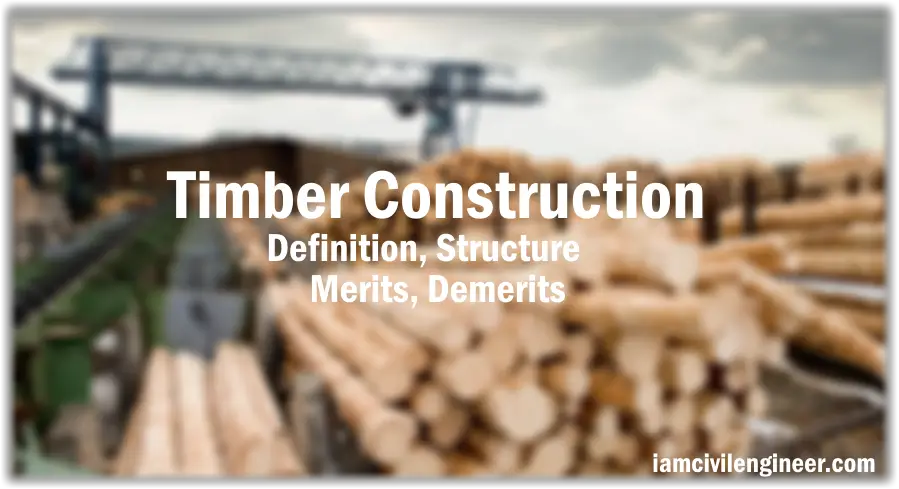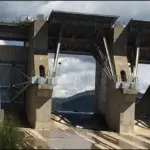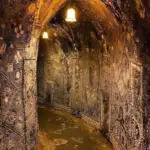Variety of Construction Materials are being used now a days depending upon the availability and transportation cost, lesser the material available expensive will be the structure and as a result structural engineer might have to think to change the material accordingly. In mountains where brick is not easily available due to less availability of plain surface timber is preferred, similarly in areas where there is great danger of earthquake and light structure is needed Timber is preferred.
In this post I will be sharing with you some key terms related to Timber engineering, merits demerits, of timber, growth of trees and structure of trees. It is a series of post related to timber construction so stay tuned for more updates.
 |
| Timber Construction |
\”In developed nations like the United States, timber is used as lumber in the construction industry and to produce furniture, pulp and paper, and wood-based composites.\”
Definition of Timber:
“Wood which is suitable for building or any other civil engineering purpose is called Timber”
When it is a port of living tree it is called standing Timber.When that tree has been felled it is called Rough Timber. When it is sawn or converted into various forms it is called “Converted Timber”
Uses of timber
Despite of the aesthetic use of timber for decoration and finishing work, Timber is used as a structural material in houses as well as structural components like beams, columns, slabs etc. Because Timber is easily available in hilly and cold areas it is used for partial and full insulation. Some times Timber is used to construct Small Span bridges as well, we can see many of the bold bridges being that of timber along with the cables. Similarly in past Railway engineers used Timber as sleepers under the railway track to bear the thrust of the steel rail gauges and to provide them stability as well.
Merits and De-merits of Timber
Timber is cheap and economical as it is easily available, in comparison to concrete where which need specified gradation of aggregates and sand as well which is not readily available in some hilly backward areas. Timber can be cut easily to any shape as required in the shape of column, beam or even you can construct truss out a timber log. Timber is durable and long lasting as far as it is dynamite proof. It is harder and light weight which enhances its ability to be constructed on sites of low bearing capacity soils.
\”Early citizens in the Massachusetts Bay Colony started to refer to sawed planks as lumber\”
But Timber has some demerits as well, It can easily be attacked by insects which can convert whole of the structure into powder just in few days. Moisture and water logging problems in few areas are destructive for it. It is less strong as compared to steel and concrete. In some plain areas it is very costly and environmental hazards and new environmental laws and regulations do not appreciate its usage.
Classification of Timber (Trees)
There are two types of trees depending upon their mode of growth;
Endogenous
Exogenous
Endogenous
( function() { if (window.CHITIKA === undefined) { window.CHITIKA = { \’units\’ : [] }; }; var unit = {\”calltype\”:\”async[2]\”,\”publisher\”:\”smsbazaar\”,\”width\”:550,\”height\”:250,\”sid\”:\”Chitika Default\”}; var placement_id = window.CHITIKA.units.length; window.CHITIKA.units.push(unit); document.write(\’
\’); }());
They grow inward in longitudinal fibrous mass. Examples are banana, bamboo, palm and cane.Their stem is rough and light yet it is flexible enough to be useful for engineers.
Exogenous
They grow outward by the addition of one concentric ring every year. These concentric rings are called annual rings. The no of concentric rings indicates no of years or age of that tree. Exogenous trees are mostly used for engineering purpose.
Exogenous trees are further classified into two types;
a) Trees yielding soft wood,
a. Conifers or evergreen
b. Trees with pointed leaves
c. Deodar, pine, chir, kail belong to this group
b) Trees yielding hard wood,
a. Deciduous with broad leaves
b. Teak, sal, shisham belong to this group
Growth and Structure of Timber Trees
The growth is done in summer and autumn season;
In spring, roots suck a solution of salt from the soil, this solution is than transmitted to the branches and leaves. The salt solution losses moisture because of evaporation, then it absorbs carbon dioxide from the atmosphere, then in the presence of sun light this solution is transformed into a viscous solution called a sap.
In autumn this sap is descend below the bark where it gets thick and its transformed into wood forming a cambium layer. Cambium layer is again with the passage of time gets thicker and thicker and is then form an annual ring. The modullary rays carry the sap from inside the bark to the interior of tree getting itself nourished.
 |
| Structure of Timber Construction |
The cross-section of the an exogenous trees shows the following structure
i) Pith or Medalla
ii) Annual Rings
iii) Heart wood
iv) Sap wood
v) Cambium layer
vi) Medullary rays
vii) Bark
Pith
The first formed round dark portion of the tree is called pith, around pith annual rings are formed the pith, when the plant is young contains large amount of fluid and it nourishes the plant. It dies up and decays when the plant becomes old.
ANNUAL RINGS
Woody fibre formed and arranged in concentric rings around the pith are called annual rings, they are called annual because each year one ring is developed, with the help of annual rings we can find the age of tree by counting dark or bright rings, each annual ring consists of two parts outer part being darker and inner one being lighter. The outer portion is dark, solid as compared to inner portion. Wood formed during spring season is called spring wood and the wood formed during summer season is called summer wood.
Bark or Cortex
It is the outermost protective covering of the tree which is exposed to air.
Heart Wood or Duramen
The central rings surrounding the pith and is near to the pith is generally darker and is called heartwood. It is non-active part of the tree and generally gives rigidity or strength to the trees.
Sap Wood
Ring near to the bark or away from pith is generally lighter in color and is weaker as well, its main task is to provide sap from root to branches. Heart wood is generally harder than sap wood thus it must be used for all types of engineering works and sap wood must be avoided as is not rigid is more exposed or liable for decomposing.
Cambium Layer
Rings between bark and sap wood constitutes cambium layer, it is that part which is not yet converted into wood. If the cambium layer is exposed to atmosphere by removing the bark it will result in ultimate death of the tree.
Medullary Rays
These are thin horizontal veins radiating from the pith towards the bark. The main purpose of modularly rays is to carry sap from inner to bark, and they also keep the inner or outer rings bound together.





















